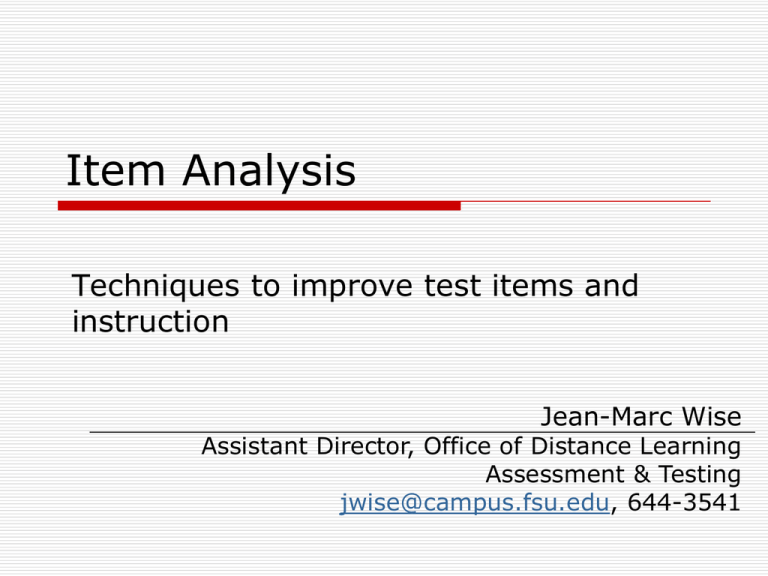Item Analysis - Office of Distance Learning
advertisement

Item Analysis Techniques to improve test items and instruction Jean-Marc Wise Assistant Director, Office of Distance Learning Assessment & Testing jwise@campus.fsu.edu, 644-3541 Item Analysis in a Nutshell Check the effectiveness of test items: 1. Score the exam and sort the results by score. 2. Select an equal number of students from each end, e.g. top 25% (upper 1/4) and bottom 25% (lower 1/4). 3. Compare the performance of these two groups on each of the test items. Item Analysis in a Nutshell For any well-written item • a greater portion of students in the upper group should have selected the correct answer. • a greater portion of students in the lower group should have selected each of the distracter (incorrect) answers. Item Difficulty Level: Definition The percentage of students who answered the item correctly. 0 High (Difficult) Medium (Moderate) Low (Easy) <= 30% > 30% AND < 80% >=80% 10 20 30 40 50 60 70 80 90 100 Item Difficulty Level: Examples Number of students who answered each item = 50 Item No. No. Correct Answers % Correct Difficulty Level 1 15 30 High 2 25 50 Medium 3 35 70 Medium 4 45 90 Low Item Difficulty Level: Discussion Is a test that nobody failed too easy? Is a test on which nobody got 100% too difficult? Should items that are “too easy” or “too difficult” be thrown out? What is Item Discrimination? Generally, students who did well on the exam should select the correct answer to any given item on the exam. The Discrimination Index distinguishes for each item between the performance of students who did well on the exam and students who did poorly. How does it work? For each item, subtract the number of students in the lower group who answered correctly from the number of students in the upper group who answered correctly. Divide the result by the number of students in one group. The Discrimination Index is listed in decimal format and ranges between -1 and 1. What is a “good” value? Number of Students achieving each Score 30 20 10 0 0 10 20 30 Hard Exam 40 50 60 Normal Exam 70 80 90 100 Easy Exam For exams with a normal distribution, a discrimination of 0.3 and above is good; 0.6 and above is very good. Values close to 0 mean that most students performed the same on an item. The index should never be negative. Item Discrimination: Examples Item No. Number of Correct Answers in Group Upper 1/4 Lower 1/4 Item Discrimination Index 1 90 20 0.7 2 80 70 0.1 3 100 0 1 4 100 100 0 5 50 50 0 6 20 60 -0.4 Number of students per group = 100 Item Discrimination: Discussion What factors could contribute to low item discrimination between the two groups of students? What is a likely cause for a negative discrimination index? Quick Reference Use the following table as a guideline to determine whether an item (or its corresponding instruction) should be considered for revision. Item Discrimination (D) Item Difficulty High Medium Low D =< 0% review review review 0% < D < 30% ok review ok D >= 30% ok ok ok Distracter Analysis: Definition Compare the performance of the highest- and lowest-scoring 25% of the students on the distracter options (i.e. the incorrect answers presented on the exam.) Fewer of the top performers should choose each of the distracters as their answer compared to the bottom performers. Distracter Analysis: Examples Item 1 A* B C D E Omit % of students in upper ¼ 20 5 0 0 0 0 % of students in the middle 15 10 10 10 5 0 % of students in lower ¼ 5 5 5 10 0 0 Item 2 A B C D* E Omit % of students in upper ¼ 0 5 5 15 0 0 % of students in the middle 0 10 15 5 20 0 % of students in lower ¼ 0 5 10 0 10 0 (*) marks the correct answer. Distracter Analysis: Discussion What is the purpose of a good distracter? Which distracters should you consider throwing out? Item Analysis Report Order ID and group number percentages counts The left half shows percentages, the right half counts. The correct option is indicated in parentheses. Point Biserial is similar to the discrimination index, but is not based on fixed upper and lower groups. For each item, it compares the mean score of students who chose the correct answer to the mean score of students who chose the wrong answer. Exercise: Interpret Item Analysis Review the sample report. Identify any exam items that may require revision. For each identified item, list your observation and a hypothesis of the nature of the problem. Reference Oosterhof, A. (1990). Classroom Applications of Educational Measurements. Merrill, Columbus, OH.





